
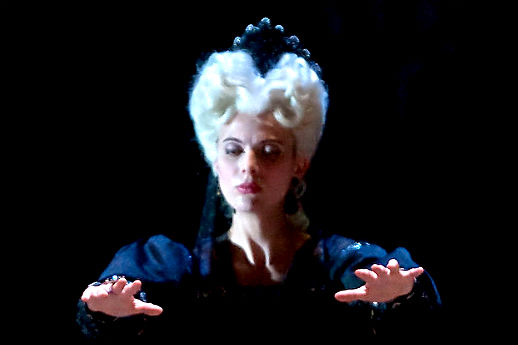
The Met opens its season with the eagerly awaited new production of Donizetti’s Anna Bolena starring Anna Netrebko. For many, however, even more highly anticipated has been the return after nearly twenty years to the Brooklyn Academy of Music of the groundbreaking production by Les Arts Florissants of Lully’s Atys (starring its very own Anna—Anna Reinhold as the goddess Cybèle) which opened on Sunday afternoon.
I also attended this production’s last performance at BAM in 1992 and remember that conductor William Christie interrupted the tumultuous applause to announce that we had just witnessed the production’s final show—after over seventy performances, it was being put to rest. However, due to the passionate interest (and millions of dollars of support) of American philanthropist Ronald P. Stanton, Atys made a triumphant return to the Opéra-Comique in February and after over twenty performances this year will close its latest run in Brooklyn on Saturday.
Originally mounted to commemorate the 300th anniversary of the death of Lully, few productions can truly claim to be epoch-making, yet this operatic landmark which opened in Italy in 1986 forever changed the fortunes of its long-neglected composer, of the group which presented it and of baroque opera in New York.
Born Giovanni Battista Lulli in Florence in 1632, the composer moved to France as a teenager where his musical talent and dancing skills (especially) soon ensured him an important place at court, as Louis XIV was passionately interested in dance. While opera was flourishing in Lully’s home country, the French had no interest in the nascent art form, preferring the ballet de cour, which, like opera, attempted to synthesize music and poetry but was clearly much more focused on dance, which in turn played no part in early Italian opera.
Royalty commonly participated in the ballet de cour as can be seen in Le Roi Danse, a rather purple film by Gérard Corbiau from 2000 depicting the complex relationship between Lully and his King. While it’s not quite as screwy as a Hollywood biography (Cornell Wilde as Chopin, anyone?), the film’s grasp on facts is suspect, but it does contain some spectacular recreations of the dance extravaganzas of the time (devised by the assistant choreographer of Atys Béatrice Massin):
(The US DVD of Le Roi Danse is out of print, but the entire film is available in consecutive sections on Youtube; its grand soundtrack is available on Deutsche Grammophon, not surprising since the orchestra is Musica Antiqua Köln.
Given that opera began in Italy in the late 16th century it’s astonishing that what is generally considered to be the first French opera didn’t appear until Robert Cambert’s Pomone in 1671. The powerful Italian Cardinal Mazarin tried to introduce Italian opera to the French in the 1640s without success, even inviting Cavalli to compose an opera for Paris in the early 1660s. Since Cavalli’s new piece wasn’t ready in time for Louis XIV’s wedding, Il Xerse was substituted. Eventually Cavalli’s Ercole Amante premiered but was not a success. However, to provide for the French taste for dance, Lully was invited to compose ballet music for both Cavalli operas, and his music was enormously successful–far outshining Cavalli’s–an important step in his increasing popularity.
The decade of the 1660s was especially important for Lully’s journey toward opera due to the collaboration between the two “Baptisti”: Lulli (now Jean-Baptiste Lully) and Jean-Baptiste Poquelin, better known as Molière. Their many works together helped create the “comédie-ballet,” an important next step in the evolution of French opera, in which Lully made enormous strides in the musical setting of the French language which had heretofore been considered far less suitable for singing than Italian. (Marc Minkowski’s CD of highlights from the Lully-Molière repertoire is absolutely delightful.
Although he often denounced all things Italian, determined to be more French than any native-born Frenchman, eventually Lully came to see that opera (albeit transformed into something quintessentially French) was where his future lay. Therefore, soon after the premiere of Pomone, Lully and his frequent librettist Philippe Quinault created in 1673 their first “tragédie en musique” (or what is more today commonly called “tragédie lyrique”) Cadmus et Hermione (a ravishing DVD of which was recently released on Alpha).
Lully was by then already 41 and at the height of his powers. It was a success and was quickly followed by a new opera each year with Atys, the fourth, premiering in 1676.
Lully had the complete support of the King, supplemented by his lettre patente which entitled him to a virtual monopoly on musical performances in Paris and allowed him to create and control the Académie Royale de Musique. For example, only operas by Lully were performed in Paris between 1673 and 1687! Lully’s rigorous exercise of this patente led to enormous jealousy and perhaps partially accounts for his longtime mediocre reputation—more known for his Machiavellian conniving than for being a genuine master composer and innovator. His gruesome death, from gangrene caused by accidentally stabbing himself in the foot with a conducting staff, also overshadowed his musical accomplishments.
However it should be remembered that his tragédies remained extremely popular after his death and Louis’s, and—other than Charpentier and his Médée–there were few rivals to his supremacy until Rameau wrote his first opera in 1733. However, by then the opéra-ballet had begun to command the public’s taste. (Despite what The New Yorker claims this week, Atys is not an opéra-ballet!). Lully’s operas continued to be done into the 1770s when a vogue for resetting Quinault’s libretti began.
J.C. Bach’s Amadis des Gaules premiered in 1779 (it’s to be revived in early 2012 in Paris), following Gluck’s 1777 Armide (due for a semi-staging in February by the new Met-Juilliard alliance), and Niccolo Piccinni even redid Atys in 1780. Soon after though, Lully’s works disappeared until the seismic revival of Atys in 1986 which stunned many who had long held that Lully’s operas, though important historically, were dry and unstageworthy. Since then, all of Lully’s full-length operas have been recorded and many of them fully staged.
Les Arts Florissants—named after a short opera by Marc-Antoine Charpentier (not the composer of the opera Louise)—was founded in 1979 by William Christie, the American harpsichordist who had settled in France after his studies with the legendary Ralph Kirkpatrick at Yale. LAF was created to focus on vocal rather than instrumental music—initially doing cantatas and short operas, and its fame rose worldwide through its CDs on Harmonia Mundi, making its first big operatic splash with Charpentier’s great masterpiece Médée released in 1984.
Les Arts Florissants made its American debut at the Metropolitan Museum of Art in 1987 and thanks to the inspired vision of Harvey Lichtenstein Atys first came to BAM in 1989, the first of many, many visits there. Despite the worthy efforts of smaller groups like Concert Royal, it’s unlikely that the US had ever seen a French baroque opera performed on such a lavish scale and with such musical flair. Since then LAF has returned many times to New York becoming an indelible part of the city’s musical life, performing over twenty operas here (mostly at BAM) either staged or in concert, rarely deviating from the Monteverdi-Lully-Charpentier-Purcell-Handel-Rameau axis that has always been the group’s focus. Whenever it visits, baroque opera always becomes the hottest ticket in town!
Because of its many tours, recordings and DVDs, Les Arts Florissants is for many US music-lovers the best-known HIP group in the world. However, its influence on baroque performance extends worldwide: many well-regarded HIP conductors played with the Les Arts Florrisants orchestra early in their careers including Patrick Cohen-Akenine, Daniel Cullier, Laurence Cummings, Mike Fentross, Emmanuelle Haïm, John Holloway, Konrad Junghänel, Kevin Mallon, Marc Minkowski, Hugo Reyne (who recently recorded a fine, small-scale Atys of his own), Christophe Rousset, Stephen Stubbs and Kenneth Weiss. Even LAF singers and chorus members have become conductors: Paul Agnew, Jérôme Corréas and Hervé Niquet.
After more than thirty years at the top of its game, Les Arts Florissants remains an innovator: recently it put online a spectacular archival website containing a treasure trove of performance annals, rehearsal, recording and performance photos, etc.
Seeing Jean-Marie Villégier’s production of Atys a fourth time (I had seen it twice in 1989, in addition to 1992), I was struck by its intriguingly paradoxical approach: while most stage movement is extremely symmetrical and stylized, the acting is always direct, powerful and free of artifice. Although some might perceive it as a strictly period production, it’s really not at all (another reason to check out the Cadmus et Hermione DVD is to note the elaborate period gesturing employed). And the unchanging magnificent faux-marble set by Carlo Tommasi bears little resemblance to the very famous designs by Carlo Vigarani that were a great attraction of Lully’s own productions.
On the other hand, Patrice Cauchetier’s ravishing costumes (nearly all in black and white except for the magical colors for those who visit Atys while he sleeps) and Daniel Blanc’s wigs beautifully evoke the lush extravagance of the seventeenth century French court.
Drawn from mythology via Ovid, the plot of Atys is relatively simple: the goddess Cybèle has become enamored of one of her earthly acolytes Atys and hopes to win his love by choosing him as the priest for her followers. Atys, however, has fallen in love with the river nymph Sangaride who returns his love, yet has been promised in marriage to King Célénus. Sangaride renounces her obligation to Célénus to run away with Atys, whom the furious Cybèle makes go mad. In his madness he believes Sangaride to be a monster and kills her. Upon coming to his senses, he sees what he has done and kills himself, where upon a chastened Cybèle transforms him into a fir tree which she will always revere. Quinault clearly sanitized the myth which usually holds that Cybèle’s wrath causes her to drive Atys mad during which he castrates himself and bleeds to death.
Diverse critical attention has been paid to examining a possible symbolic subtext for Atys. It’s commonly believed that Louis XIV routinely chose the story for each of Lully’s operas. Some have argued that Louis’s choice here was a subtle warning to Lully to rein in his increasingly infamous homosexual liaisons. It’s often claimed that Louis detested sodomitic behavior, yet it should be remembered that Louis’s own brother Philippe, the Duc d’Orléans (usually referred to as “Monsieur”), was widely known to be gay, despite having a wife and children (as did Lully).
This reading evolves from the highly feminized cult of the earth mother Cybèle which was believed to be peopled by men who had castrated themselves in an ecstatic frenzy and then later dressed themselves as women. On the other hand, it’s been also been suggested that rather Lully and Quinault trumped the King by making the opera into a cautionary tale about how a ruler who becomes distracted from “his” duties by inappropriate passions is eventually betrayed.
For those familiar only with the baroque repertoire in Italian from Monteverdi to Cavalli to Scarlatti, French opera of the seventeenth century is indeed from another world. Divided into five acts to mirror the construction of French spoken tragedy (think Racine), a prologue was then added less to introduce the plot than to sing Louis’s praises. One can mount an Italian opera with a small orchestra and six to ten singers, but French operas require much larger forces; Atys features an orchestra of fifty, a chorus of over thirty, eleven dancers and twenty solo singers.
And it’s a long haul—over four hours including two intermissions; despite the near-universal acclaim that Atys has received over the past twenty-five years, one can’t pretend that the work has no longeurs. There are many extended passages of recitative between two characters which only occasionally blossom into a brief, more melodic aria-like form, yet each act is constructed to feature a musically rich extended spectacle or divertissement generally featuring the chorus and ballet: the entrance of Cybèle in act 1, the (interrupted) wedding in act 4 or the ravishing Sommeil (sleeping scene) in act 3 which became probably the most famous scene in all Lully and was often copied or parodied:
The 2011 cast includes a combination of newcomers and LAF veterans, including a lone survivor from the 1986 original cast, Bernard Deletré who got off to a rocky start as Le Temps in the prologue but returned later for a riotous turn as Sangar, the heroine’s tipsy father. Sophie Daneman was particularly stylish as Doris, while Nicolas Rivenq was stalwart as the triply-betrayed King Célénus. Among the many newcomers in small roles, Élodie Fonnard stood out in the prologue as Flore and as part of the charming trio during the wedding scene.
In the three main roles, some of the new cast struggled with the ghosts of those who had so memorably preceded them. Emmanuele de Negri was a really lovely Sangaride, singing strongly yet she lacked the otherworldly beauty of Agnès Mellon or the passionate intensity of Ann Monoyios.
The most disappointing performance of the afternoon was, unfortunately, that of the title role. When two superb haut-contres Paul Agnew and Cyril Auvity (especially winning as Morphée) were on stage during the Sommeil scene, I was baffled why one of them—rather than Ed Lyon—had not been cast as Atys. Lyon was certainly hard-working, but all that effort was usually far too apparent, unlike the seemingly effortless heroic stature that ennobled the magnificent Atys of Howard Crook, star of both the 1989 and 1992 BAM tours (and who can seen on a much coveted video of the 1987 telecast from Montpellier).
Also, since Lyon’s voice lacked freedom at the top, one wondered if he is really suited to this repertoire, although his Pygmalion with LAF at Alice Tully Hall earlier this year was somewhat better. Based on the telecast from Paris from February, it seems most unfortunate that Swiss tenor Bernhard Richter, so wonderful in the title role, wasn’t engaged for the New York run. That telecast, however, will form the basis of an upcoming DVD release of this revival.
The revelation of the performance came from the most unexpected member of the cast: Reinhold in the pivotal role of the goddess Cybèle. Like Lyon, she was not cast in the role for the Paris run; Cybèle was sung there by the striking French mezzo Stéphanie d’Oustrac, currently singing Sesto at the Palais Garnier for the Paris Opéra. D’Oustrac’s portrayal was such a highlight of the earlier performances that I suspect many were quite unhappy she wasn’t making the trip to BAM.
However, the very young Reinhold (still in her mid-twenties) didn’t disappoint; lacking Guillemette Laurens’s indomitable authority or d’Oustrac’s opulent conflicted sensuality, Reinhold remade the role into a young and vulnerable goddess experiencing love for the very first time (as pointed out by her confidante Melisse, well done by a tart Ingrid Perruche). Although she started out somewhat tentatively, Reinhold steadily gained in confidence, using her lightish, clear voice to commandingly put across Quinault’s beautiful text. She made something really moving of Cybèle’s monologue at the end of the third act, and her quietly devastated mien riveted one’s attention during the magnificent final chorus commemorating Atys’s apotheosis into the fir tree.
Initially the orchestra sounded a bit muffled and the chorus off-form—the entire first section (the prologue and Act 1) didn’t seem to make its usual impact. But both groups quickly recovered after intermission and again reminded one of why LAF performances are so revered in this repertoire. The splendid large continuo group (called the petit choeur) was a particular highlight, led by the incomparable Béatrice Martin and Benoît Hartoin at the harpsichords and Anne-Marie Lasla on the gamba.
An added bonus was the sterling performance of the many dance numbers choreographed by the late Francine Lancelot and danced by the really excellent Compagnie Fêtes Galantes.
Atys isn’t the only show being done during this visit by Les Arts Florissants: five young singers who performed smaller roles in Atys, along with Reinhold, are members of this year’s fifth edition of “Le Jardin des Voix” (LAF’s biennial academy for young singers) and it will performing a pasticcio Le Jardin de Monsieur Lully on Sunday 25 September at BAM’s smaller Harvey Theater. I have seen a video of the piece, and it’s really lovely and well worth investigating. And New Yorkers can rejoice that Les Arts Florissants is rumored to be returning in the spring of 2013 with an Andreas Homoki staging of the Biblical masterpiece David et Jonathas. by Charpentier, an even greater composer than Lully!
(Photos of BAM Atys: Stephanie Berger)















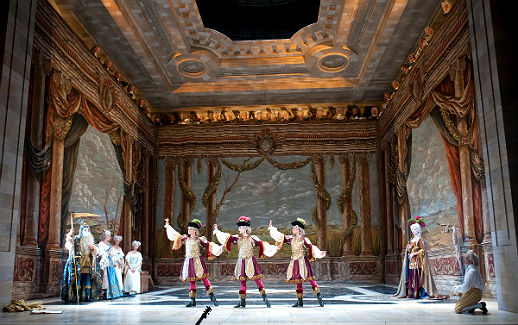

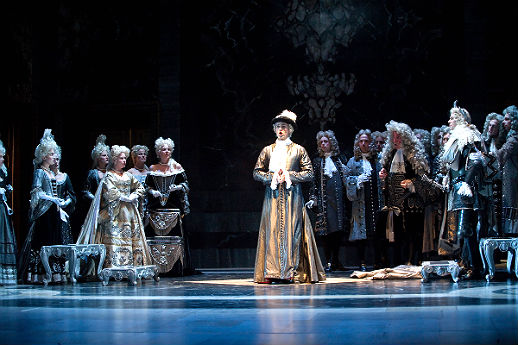

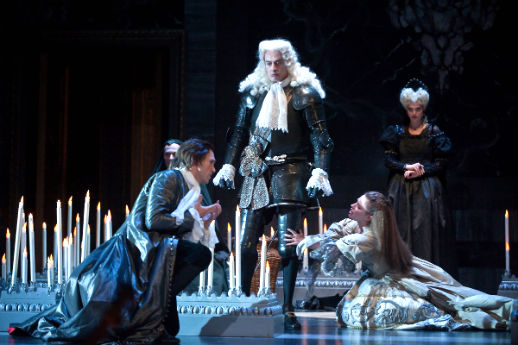


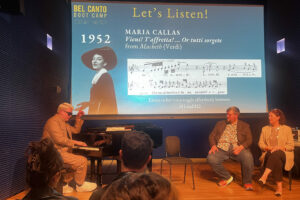









Comments